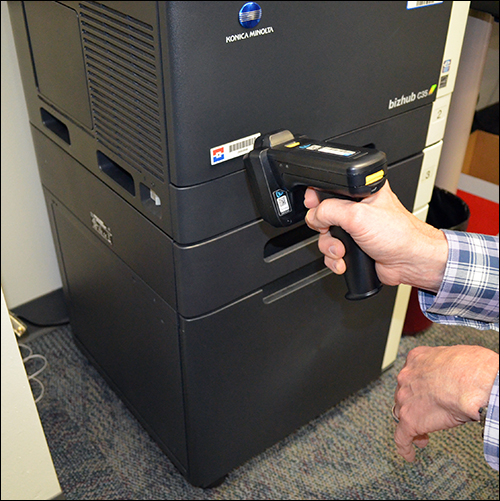Feb 10, 2017The Dallas County Community College District (DCCCD) has deployed an asset-management system employing radio frequency identification technology to locate its tens of thousands of assets across seven campuses and two satellite locations. The district is currently in the process of applying tags to its IT assets, musical instruments, medical equipment and farm animals, in order to monitor where they are located, based on bi-annual audits. In some cases, rooms containing tagged items—computer labs, for instance—are also equipped with fixed reader portals to identify whenever an asset passes through the door. The solution, known as Virtual Asset Tracker (VAT), is provided by Radiant RFID.
The DCCCD is a network of seven independently accredited Texas colleges in Brookhaven, Cedar Valley, Eastfield, El Centro, Mountain View, North Lake and Richland. The ultrahigh-frequency (UHF) RFID-based solution is being deployed at each of these locations, as well as at a support site and district office building, according to Misherlae Pace, the DCCCD's District Service Center project coordinator.
The district has thousands of assets, Pace says, which are typically counted and audited about once a year. Those physical counts, carried out at its nine locations, take place from November to March of the following year, and then require auditing of the results. "Conducting these inventory counts at every campus is a very arduous process," she states. The district spends a large amount of money for the labor involved in those counts, and because they are performed manually, the information is still often outdated, or errors can be made.
So in 2016, the district opted to deploy the VAT system from Radiant RFID, consisting of a TSL 1128 Sled handheld UHF RFID reader (with a Bluetooth connection to an Apple iPod Touch), as well as fixed Impinj and Zebra Technologies readers, a variety of RFID tags, hosted RFID VAT software, onsite training and customer support. DCCCD is also using Radiant RFID's VAT2Go app to enable access to RFID-based asset-location data from a mobile device, explains Megan Ward, Radiant RFID's sales and marketing director.
DCCCD has multiple software platforms in use, Pace explains, and needed VAT to seamlessly integrate and share data with these systems. Radiant RFID's Automated Import and Export Module is intended to make this process easy, she says.
The solution—which is slated to be taken fully live later this year—will work this way: As staff members tag items, such as routers, furniture, PCs, printers and musical instruments, a tag (with a bar code printed on the front) is affixed to each object's surface. The ID number for that tag can be interrogated via an RFID reader, scanned from the bar code or input into the system using an iPod Touch running the VAT2Go app, and location data—such as the room number—is entered with that ID. The ID is linked to the item's description and any serial number. The VAT software then stores that data, along with the location assigned to that item.
Inventory counts will take place approximately twice a year, during which a worker will arrive at a room and input the room number in the app, which will then retrieve data indicating which items should be at that location. In some cases, the school district may also apply a bar code at a room's entrance, so that the bar code can be scanned to identify that location. The employee will walk through the room carrying the handheld, which will capture each ID number and forward that information to the tablet via a Bluetooth connection. The app will then transmit the collected read data to the hosted software.
The VAT software will be integrated with the district's own inventory-management software as well. If any tag IDs that the software had allocated to that room are not read, the system will display those missing items on the iPod tablet, or on a smartphone using the app.
The district expects personnel to be able to count all inventory within a single room via the handheld device in about three minutes. Previously, the process could have taken an hour or longer. The district intends to have all pieces of equipment valued at more than $1,000 each tagged by November 2017, totaling 63,000 items. It will also tag around 30,000 equipment items valued at less than $1,000 apiece, such as some tablets and laptops. Approximately 80 percent of the tagging is anticipated to be completed in June.
While there are currently four fixed readers in place, the district plans to add about four more, primarily at the entrances to the schools' computer labs.
The greatest benefit that the technology will provide the district will be a reduction in labor, Pace predicts. "We will be able to cut down tremendously on our staff time" previously expended on inventory counts, she says. "The system will pay for itself in labor hours." The auditing of inventory data will be different as well, Pace adds. While audits of manual inventory counts required time for employees to confirm the gathered information, and to determine where missing assets might be located, the RFID system will make that auditing process automatic.
In addition, because the app also utilizes location data from the mobile phone running the app, if a worker were to take a piece of equipment home and read that item's tag on his or her phone, the app would detect the unexpected location. This would help to ensure that employees do not simply remove items from a campus without the district's knowledge.
DCCCD posed challenges typical of a college environment for Radiant RFID, Ward says. "For us, it's a pretty standard deployment," she states. "We really understand the challenges higher education has."




